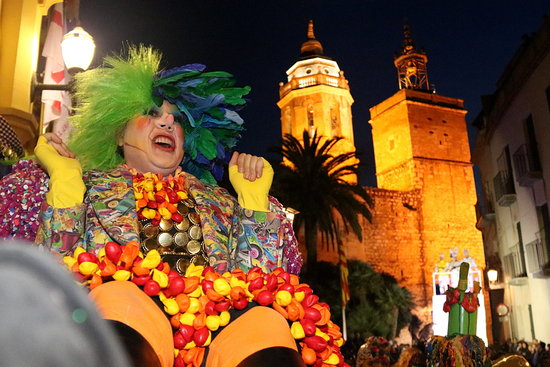Food fights, feasts and festas: Carnival kicks off!
Seven-day celebration sees street parties and parades in cities, towns and villages across Catalonia

Rio de Janeiro has its samba parties and New Orleans its Mardi Gras, but did you know that Catalonia is crazy for Carnival too?
Bed races, sardine burials and donkey hangings (not real donkeys, I should add) are some of the more surprising ways that Catalans let their hair down in the hedonistic days before the traditional abstinence of Lent.
While some celebrations get going early, Dijous Gras or Fat Thursday is when the festivities really start to ramp up.
So with plenty of parades and parties to look forward to from February 20 - 26, here’s the Catalan News guide to Carnival 2020.
Vilanova i la Geltrú
The seaside town of Vilanova i la Geltrú is undoubtedly one of the go-to destinations for Carnival. 'La Merengada' on Dijous Gras is a sight to behold, with hundreds of children throwing sticky meringue mix at each other before a gigantic meringue is lowered into the crowd from the balcony of Blanch’s cake shop in the town.
Alongside raincoats, appropriate footwear and clothes you don’t mind getting dirty, organizers advise bringing "a desire to take part," and adults have no excuse not to, with their own meringue war at midnight in the 'Merengada Nocturna.'
Friday sees the Rei Carnestoltes, or Carnival King, deliver a sermon to his gathered subjects, while Sunday sees the climax of the Vilanova Carnival with a sea of sound and color as bands parade through the town before it descends into the inevitable... more food fights!
Sitges
Just north of Vilanova along the coast, Sitges is another spot that takes its Carnival fun seriously. The festivities kick off on Dijous Gras with the arrival of the King of Carnival and his entourage.
Big parades follow, like the Debauchery Parade on Sunday and the Extermination Parade on Tuesday, which draw tens of thousands of revelers to party on the beachfront and medieval streets.
Confetti battles and bed races
Of course, Barcelona also gets in on the Carnival hi-jinks with parades, costumes, dancing, and singing throughout the Catalan capital. The King of Fools is joined by a motley crew of seven ambassadors with a penchant for the seven deadly sins, which explains their delightful sobriquets. Lord of Me-me-me and Count of Big Belly the Viscount of More-food are two of my favorites.
Or why not visit Reus, where you can take part in a confetti battle and witness the burning of King Carnestoltes’ arm, or Solsona, where a cardboard donkey is hung from the town bell tower while the townspeople, known as donkey hangers, beat out rhythms and sing songs.
Big carnival parades and feasts also take place in Platja d’Aro, Tarragona, Ribes, Palmós, and countless villages throughout the country.
Be careful of having a lazing Sunday lie-in in Lleida in western Catalonia. You might just find yourself unwittingly part of their bed race, which is exactly what the name suggests, and quite a spectacle.
Burial of the Sardine
The only way to round off a Catalan Carnival is with the 'Burial of the Sardine' ritual on Ash Wednesday. This mysterious, somber ceremony takes place all across Catalonia and is supposedly inspired by a surreal Goya painting.
It coincides with the beginning of the traditional Lenten period of abstinence, which after seven days of good times and gluttony, some may thankful to see.